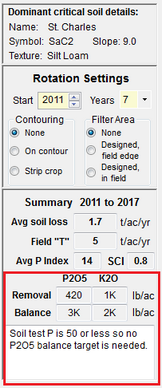P2O5 and K20 Removal and Balance |

|

|
|
P2O5 and K20 Removal and Balance |

|

|
|
|
||
The P205 and K20 removal show the expected crop removal across the rotation. The P2O5 and K2O balances represent the difference between total applications and crop removal over the duration of the rotation. Positive balances indicate that soil P and K concentrations are likely to be rising. Negative balances mean that soil concentrations may be going down over the rotation.

Phosphorus-based Planning Notes:
•The 590 Nutrient Management Standard requires that where manure or organic by-products are applied during the crop rotation, the nutrient management plan must calculate a rotation average P Index or a rotation P2O5 balance for each field. A single phosphorus management strategy, either the P Index or the P2O5 balance, shall be applied uniformly to all fields within a farm or tract, for up to an 8-year rotation in each field.
•The P2O5 balance requirement is based on the soil test P level. If soil test levels are below 50 ppm P, then there is no limit on the P2O5 balance. If soil test levels are above 50 ppm P, then the P2O5 balance target will be listed in the text box below the balances.
•The planned rotation average P Index values must be 6 or lower. Phosphorus applications on fields with an average PI greater than 6 may be made only if additional P is needed according to UWEX soil fertility recommendations.